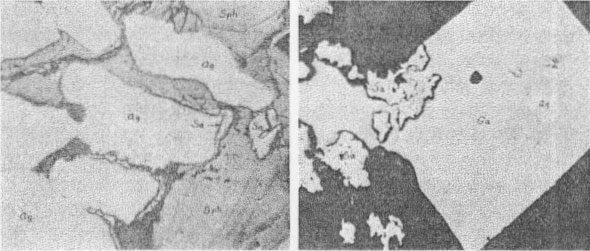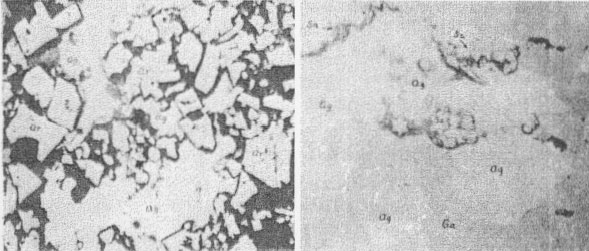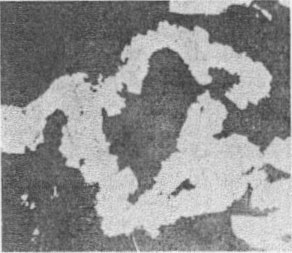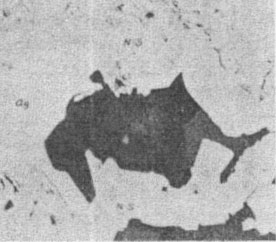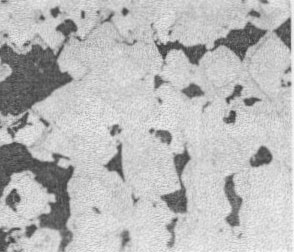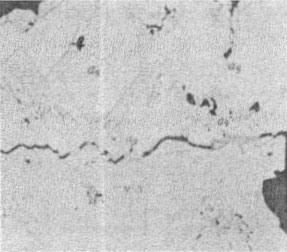| Home | AmMin | GMR | RiMG | Collectors Corner | Directory | Short Courses | |
|
|
|||||||

|
|
Volume 20, pages 715-723, 1935
PRIMARY NATIVE SILVER ORES AT BATOPILAS, MEXICO, AND BULLARD'S PEAK, NEW MEXICO PHILIP KRIEGER, Columbia University, New York City. INTRODUCTION Many of the silver deposits on which there is seemingly general agreement as to their hypogene (primary) origin, and particularly those deposits in which native silver is a fairly common constituent, show a characteristic association of nickel and cobalt arsenides with native silver or other silver minerals. In view of the generally recognized hypogene origin of the nickel and cobalt arsenides this association has been used as one of the criteria for the primary origin of native silver. Such an association has been observed in a number of localities and described by various writers. It is one of the striking features of the silver deposits in the Erzgebirge of Europe. A similar association in the mines of the Cobalt district of Ontario is so well known that further mention is not necessary. In addition to these two best known of the districts where this association is common, Bastin1 has also described silver deposits near Wickenburg, Arizona, where the same association is found and where he believes much of the native silver as well as other silver minerals are due to hypogene mineralization. More recently the deposits of the Great Bear Lake district have been studied by Kidd2 where a similar association is noted. Piepoli3 has described the ores of Sarrabus, Sardinia, where cobalt and nickel arsenides are associated with native silver and pyrargyrite. The silver minerals at this locality are also considered to be of primary origin. At Sabinal, in Chihuahua, Mexico,4 native silver and other silver minerals are intimately intergrown and associated with similar arsenides and with galena, sphalerite, chalcopyrite and pyrite. Such an association of minerals and the manner of their occurrence leaves little doubt as to the hypogene origin of the native silver at this locality also. Recent study of material from two additional localities shows a similar mineralogical association. At Batopilas, in Chihuahua, Mexico, silver mineralization occurs which appears to be typically primary, with native silver and the sulpho-salts of silver intimately intergrown with arsenides of cobalt and nickel, arsenopyrite, and with the sulphides of zinc and lead. The field relations at Batopilas and the fact that some of the veins have been mined to depths of 1700 feet below the surface outcrops also support the view that silver mineralization here is of hypogene origin. A specimen of native silver ore from the Bullard's Peak district, New Mexico, also shows native silver associated with a cobalt-nickel arsenide. Although this locality was not examined in the field, a microscopic study of the ore indicates that the native silver is probably also of a primary nature. BATOPILAS DISTRICT, CHIHUAHUA, MEXICO This district is located in one of the more rugged portions of the Sierra Madre mountains of southwestern Chihuahua, approximately 60 miles south of Creel, the end of a branch line of the Mexican Northwestern Railroad. The mines have been operated intermittently since their discovery in 1632 and have yielded, at times, remarkably rich bonanzas of native silver ore. Despite the fact that Batopilas has been known as a silver producing district. for more than three centuries and has yielded over 50 million ounces of silver, surprisingly little has ever been published concerning the geology or mineralization of this famous locality. The mines have long been noted for the beauty and variety of native silver specimens and crystals of ruby silver, examples of which can be found in many of the larger museums throughout this country and in Mexico. The ore occurs in a series of well defined fissure veins in diorite or andesite that has been intruded by a fairly coarse textured granite. By far the greater portion of the veins, particularly those from which the bulk of the silver has been produced, strike nearly north-south. In the San Miguel mine a few minor cross veins with a nearly east-west strike have also yielded considerable silver. The veins vary in dip from 65 degrees west to vertical. Gangue material in the veins consists almost entirely of calcite with only minor amounts of quartz and barite. A preliminary study of the geology of the district indicates that the mineralization was probably connected with the granite intrusive. The present study is intended to illustrate some of the microscopic features of the ore minerals and to show the association of silver minerals with cobalt and nickel arsenides and with the sulphides of other metals. A more detailed study of the general geologic features of the district is being planned. THE ORES. Most of the ore derived from the veins consists of native silver with subordinate amounts of polybasite, argentite, proustite and pyrargyrite. Pyrite, galena and a very light, amber colored sphalerite are also present. Large masses of cerargyrite are also reported to have been mined near the surface outcrop of the veins during early mining operations. Microscopic study of the ore shows additional minerals which, from their association and structural relations, afford good evidence for the primary origin of these ores and support the field evidence for such an origin. Although safflorite and rammelsbergite, together with arsenopyrite, rarely occur in sufficient quantity as to be visible to the unaided eye, they were readily observed in nearly all of the polished sections examined under the microscope. These minerals are considered significant as regards the origin of the silver minerals. Rhombic forms and stellar shaped twin crystals of safflorite and rammelsbergite are fairly common and are intimately associated with native silver, galena, sphalerite and the sulpho-salts of silver. Some of these are shown in Figs. 1 to 4. Euhedral crystals of arsenopyrite are likewise common and are also associated with native silver. A slight time interval may have existed between deposition of the various minerals in this group but they are so intimately intergrown with each other and present such closely related structural and textural features that a similar origin must be assigned to each of them, including the silver minerals. Thus, the ores at Batopilas resemble, in many respects, other silver deposits where similar mineral assemblages have been noted and where native silver is generally recognized as being of primary origin. The absence of evidence indicating oxidation or enrichment by supergene processes supports this conclusion. An exact order of deposition for each of the metallic minerals is difficult to establish. In general, however, the silver minerals belong to the last stages of metallic mineralization and appear to be, in greater part, later than the arsenides and arsenopyrite. Evidence for this is to be seen by the manner in which native silver has penetrated between individual crystals of these minerals and by modification of their crystal form when in contact with native silver. Native silver is distinctly younger than sphalerite. This is indicated by small veinlets of native silver within fractures in sphalerite. Likewise, native silver appears to be, at least in part, later than galena, as indicated by small hybrid veinlets which sometimes penetrate the latter mineral. Such veinlets, however, are not abundant and in most of the specimens examined the relation between these two minerals could not be definitely established. It is quite possible that contemporaneous deposition of galena and native silver took place, with native silver continuing to be deposited over a slightly longer period of time.
The relations observed between the sulphosalts of silver also indicate contemporaneous deposition. Specimens available did not show these minerals in contact with native silver so this relationship could not be determined. Remnant crystals of the arsenides within polybasite and proustite indicate that the arsenides were deposited earlier in the sequence of mineralization. The occurrence of well formed, stellar shaped twins and euhedral rhombic crystals of safflorite and rammelsbergite within galena and sphalerite suggests that the arsenides are the younger of these minerals. Pyrite is found largely in the wall rock of the veins and has not been observed in contact with other metallics. Under normal conditions it would be expected to be one of the earlier metallic minerals minerals to crystallize. Although an exact sequence in the deposition of these minerals cannot be established the general order in which they were deposited appears to be as follows: (1) deposition of the sulphides, including pyrite, sphalerite and galena; (2) deposition of the nickel and cobalt arsenides and arsenopyrite; (3) deposition of the silver minerals, with native silver probably continuing as one of the last of the metallics. BULLARD'S PEAK DISTRICT, NEW MEXICO Waller and Moses,5 in 1892, described what they thought was probably a new nickel arsenide from this locality. In addition to arsenic, analysis showed the presence of nickel, cobalt and iron. The combined ratio of these elements corresponded to the ratio for skutterudite, the cobalt tri-arsenide, and the name "nickel-skutterudite" was suggested for the mineral. Recent x-ray work by Holmes6 on a specimen of this material in the Egleston Collection at Columbia University shows a diffraction pattern corresponding to that of skutterudite from Skutterud, Norway, confirming the earlier work of Waller and Moses. The nickel-skutterudite is found intimately associated with native silver in a gangue of quartz, calcite and siderite. According to early accounts of its occurrence, the arsenide was not present in the upper 100 feet of the mine. Below the 100 foot level, however, and to a depth of 690 feet, the lowest workings at that time, it was found in appreciable quantities. Polished surfaces of the material show a striking similarity to some of the ores of Cobalt, Ontario, and to some of the European deposits. The material also contains a variety of structures which may have a bearing on the paragenesis of the two minerals and appear to support the recent experiments of Schouten7 on structures obtained by synthetic replacement of similar materials. The native silver occurs in arborescent masses, most of which show good crystalline form and is nearly always surrounded by bands of nickel-skutterudite. In addition to the bands surrounding native silver, the nickel-skutterudite also occurs as groups of crystals similar to the tubercle forms described by Bastin8 from the Cobalt district. In such cases the arsenide surrounds gangue minerals with the interior of the crystal groups entirely devoid of native silver or but partially filled with native silver. In most instances, however, the interiors of the crystal groups are entirely filled with native silver, many of which show good crystal faces against the nickel-skutterudite. One conclusion regarding the paragenesis of the two minerals appears evident. Some of the native silver was deposited after deposition of the arsenide. This is shown by fractures and small veinlets in the arsenide that contain native silver. In some instances the opposite walls of the fractures match perfectly so that simple fracture filling appears to have taken place. Other instances, however, show irregular veinlets with walls that do not match, indicating that some replacement may also have occurred.
Several features concerning the tubercle-like forms of nickel-skutterudite are of interest because they show evidence which suggests that native silver may have been deposited by so-called "centrifugal" replacement as suggested by Schouten9 as the result of his work on synthetic structures. Where these forms surround only gangue minerals they show a striking development of crystal faces on both the inner and outer border of the arsenide. Such a form is shown in Fig. 5. When the interiors of these tubercle-like forms are filled with native silver, however, the crystal faces of the arsenide on the inner border are largely destroyed and the crystal form of the native silver is substituted. Several instances were noted where a tubercle was but partially filled with native silver. Where the two minerals are in contact with each other the crystal faces of the arsenide appear to have been destroyed, but where they are not in contact, the crystal faces of the arsenide are still present. Occasional remnants of the arsenide within native silver are also present. In presenting the above evidence the author fully realizes that it is only suggestive and cannot be taken as conclusive evidence in itself, since it is quite possible that simultaneous deposition of the two minerals may have taken place to a certain extent. However, in view of the fact that at least some of the native silver is later than the arsenide, the weight of the evidence presented supports the younger age of the native silver. The question as to the sequence of the two minerals does not detract from the significance of this association as regards the origin of the native silver. This association of arsenides with native silver appears to be so typical of those native silver ores which are generally recognized as being due to hypogene mineralization that a similar origin for this ore seems probable. This conclusion is further supported by the fact that oxidation products are absent in the ore. CONCLUSIONS The association of nickel and cobalt arsenides with native silver is becoming increasingly common as silver deposits are being studied in greater detail. Two additional localities showing this association are presented in the present study. At Batopilas, native silver is associated with safflorite and rammelsbergite, and with arsenopyrite, galena and sphalerite. Such an assemblage of minerals and the manner of their occurrence indicates that native silver at this locality is of hypogene (primary) origin. A preliminary study of the field relations supports the microscopic evidence for such an origin. So far as known, this is the second locality in Mexico where such an association has been reported and where native silver is believed to be of primary origin. Microscopic study of material from the Bullard's Peak district, New Mexico, shows native silver associated with a nickel-skutterudite. This association is strikingly similar to the association of native silver and arsenides in the Cobalt district of Ontario. A primary origin for the native silver at this locality is also advocated. The material from Bullard's Peak district also shows evidence suggestive of centrifugal replacement of the arsenide by native silver. The trip into Batopilas was made in the company of Mr. J. Conness Shepard, of Chihuahua City, to whom sincere appreciation is extended for information concerning the mines during their operation by Governor Alexander Shepard. NOTES 1 Bastin, E. S., Primary Native Silver Ores near Wickenburg, Arizona, and their Bearing on the Genesis of the Silver Ores of Cobalt, Ontario: Bull. 735, U. S. Geol. Survey, 1922, pp. 131-154. 2 Kidd, D. F., A Pitchblende Silver Deposit, Great Bear Lake, Canada: Econ. Geol., vol.27, pp. 149-159, 1932. 3 Piepoli, M. P., Etude microscopique de quelques minerais des filons argentiferes du Sarrabus (Sardaigne): Soc. Franc. Miner., Bull. 56, (6-7-8), pp. 277-302, 1933. 4 Krieger, P., Primary Silver Mineralization at Sabinal, Chihuahua, Mexico: Econ. Geol., vol. 30, pp. 242-259, 1935. 5 Waller, E., and Moses, A. J., A Probably New Nickel Arsenide: School of Mines Quarterly, vol. 14, pp. 49-51,1892-3. 6 Holmes, R. J., Paper presented before the 15th annual meeting of the Mineralogical Society of America at Rochester, New York, December, 1934. 7 Schouten, C., Structures and Textures of Synthetic Replacements: Econ. Geol., vol. 29, pp. 611-658, 1934. 8 Bastin, E. S., Primary Native Silver Ores of South Lorraine and Cobalt, Ontario: Econ. Geol., vol. 20, pp. 1-24, 1925. 9 Op. cit. | ||||||||||||||||
